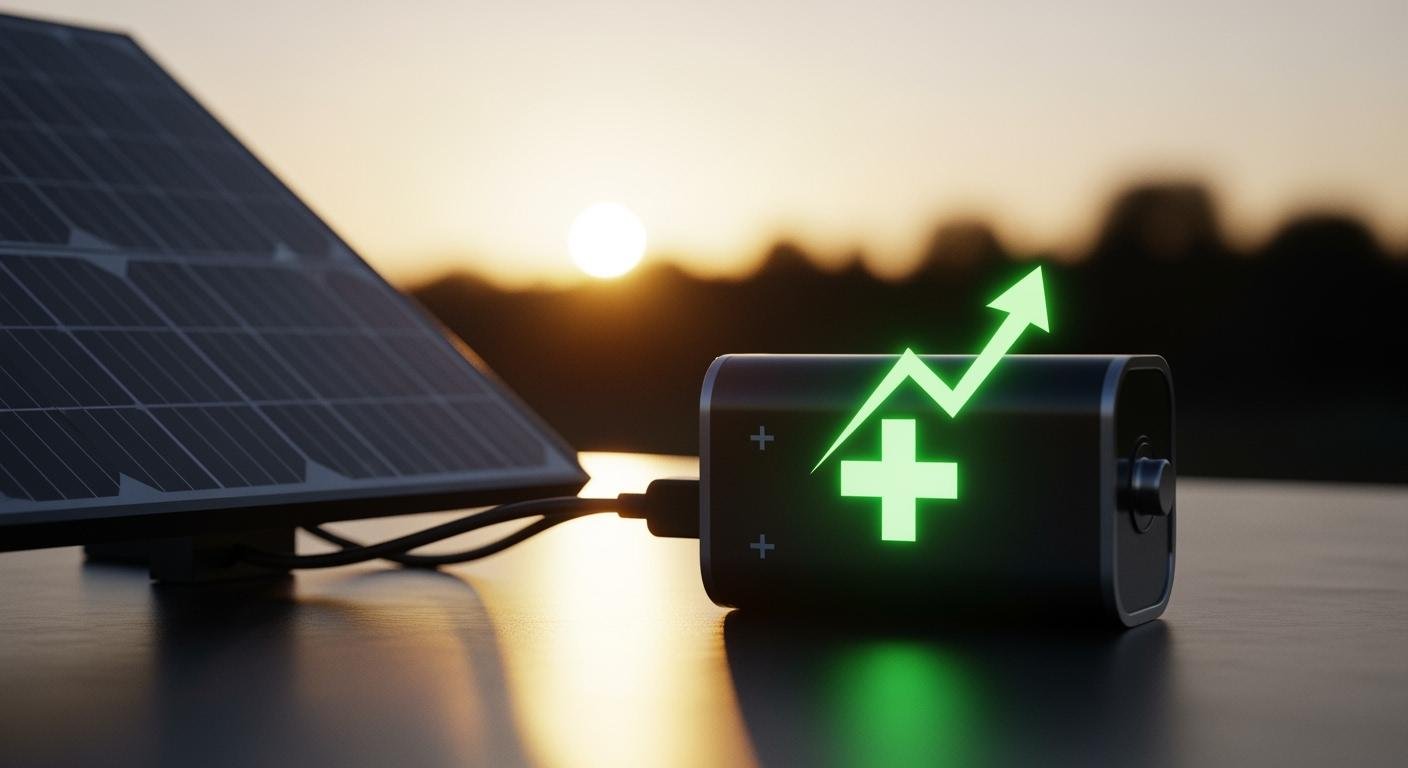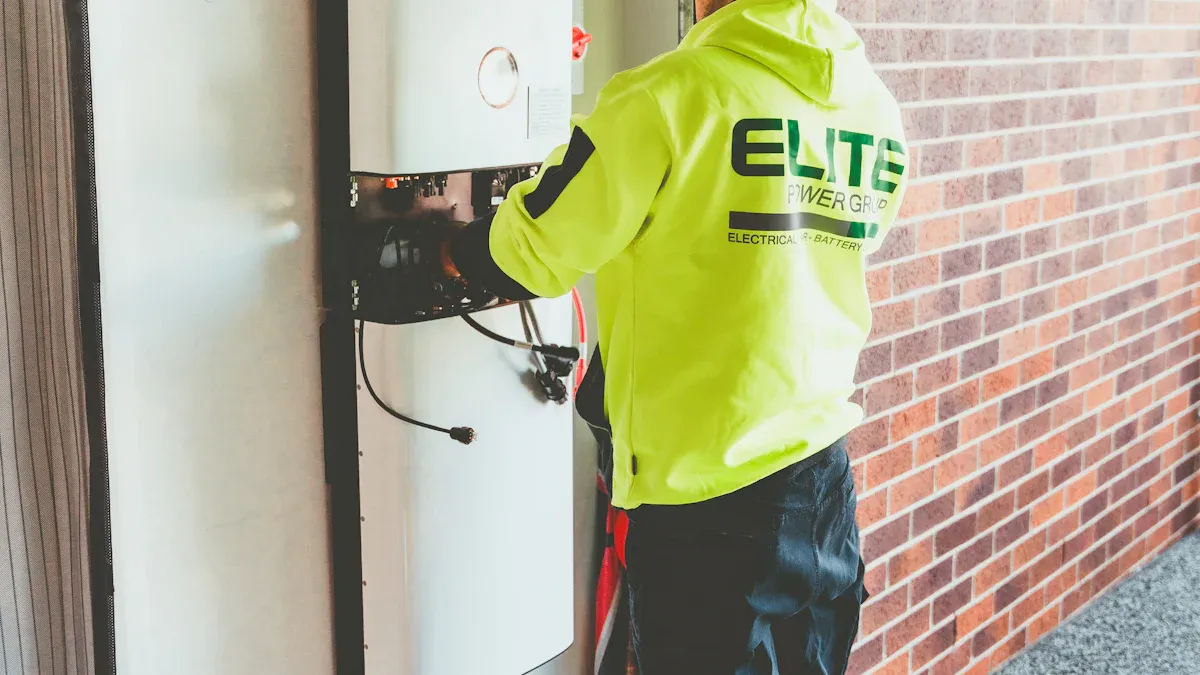
You can improve battery life for your solar system. A typical solar battery has a battery life expectancy of 10 to 15 years, though many factors affecting solar battery life can alter this. You can optimise your solar battery lifespan by focusing on four key areas to ensure better efficiency.
- Optimized charging
- Environmental control
- System calibration
- Regular maintenance
These actions protect your valuable solar battery storage investment. They help ensure your solar power is reliable for years to come.
Smart Charging to Improve Battery Life
Smart charging habits are essential to improve battery life for your solar system. You can actively manage how your battery charges and discharges. This helps you get the most out of your solar battery storage investment and boosts its overall efficiency. These simple strategies will help you protect your battery for the long term.
Manage Depth of Discharge (DoD)
You should manage your battery’s Entladungstiefe (DoD). DoD is the percentage of the battery that has been used. For example, if you use half of your battery’s stored energy, its DoD is 50%. Regularly discharging a battery too deeply places stress on its internal parts. This can shorten its battery life expectancy and prevent premature degradation.
While some modern batteries like the Enphase IQ are designed for 100% DoD, many others benefit from shallower discharging. You can often double your battery’s lifespan by keeping the DoD around 50%.
| Entladungstiefe (DoD) | Estimated Cycle Life |
|---|---|
| 100% | ~3,000 cycles |
| 80% | ~5,000 cycles |
| 50% | ~8,000 cycles |
Tipp: Use a solar monitoring system to monitor charge levels. This helps you keep the battery within its ideal range and discharge smartly.
Avoid Overcharging Your Battery
Your solar system has a Battery Management System (BMS). The BMS is a crucial component that acts as the brain of your battery. It protects your battery from overcharging. Overcharging can cause overheating and damage. The BMS constantly checks the voltage of each battery cell. If the voltage gets too high during charging, the BMS automatically cuts off the power.
You should ensure your BMS is working correctly. Watch for signs of a problem, such as:
- Physical swelling of the battery case
- Error codes on your system display
- A noticeable drop in battery capacity
A healthy BMS is key to the safety and efficiency of your solar battery storage.
Leverage Time-of-Use (TOU) Rates
You can use your solar battery to save money if your utility company has Time-of-Use (TOU) rates. TOU rates mean electricity costs more during peak demand hours. You can program your solar system to use battery power during these expensive peak hours. This allows you to maximise solar charging benefits.
For example, some utilities in California have peak hours from 4:00 PM to 9:00 PM. Your system can charge the battery with solar power during the day. Then, you can use that stored energy in the evening instead of buying expensive grid power. This is a great way to optimise your energy savings with your solar setup.
Control the Operating Environment

You can protect your solar battery by managing its physical surroundings. The environment where your battery operates directly impacts its health and longevity. Paying attention to temperature, cleanliness, and airflow helps your solar system perform at its best.
Maintain Optimal Temperatures
Temperature is one of the most critical factors for battery health. Extreme heat or cold can reduce your battery’s lifespan and overall efficiency. Each battery type has a preferred temperature range for peak performance.
| Akku-Typ | Ideal Operating Temperature Range |
|---|---|
| Lithium-Ionen | -20°C to 60°C (-4°F to 140°F) |
| Blei-Säure | 20°C to 30°C (68°F to 86°F) |
Anmerkung: High temperatures accelerate chemical reactions inside the battery, causing it to degrade faster. For every 10°C (50°F) increase above the ideal temperature, your battery’s life can be cut in half.
For charging a lithium-ion solar battery, you should keep it between 0°C and 45°C (32°F to 113°F).
Keep Terminals Clean and Dry
Clean battery terminals ensure a solid connection for your solar setup. Corrosion can build up over time and create resistance, which forces your system to work harder. You can clean corroded terminals yourself with a few simple steps.
- Wear a face shield and protective clothing.
- Mix about 1/2 cup of baking soda into 1/2 gallon of water.
- Use a clean rag to apply the solution to the terminals.
- Gently scrub with a nylon brush until the bubbling stops.
- Rinse the terminals with clean water and dry them completely.
Ensure Proper Ventilation
Proper ventilation is essential for safety and performance. It allows heat to escape and prevents the buildup of gases, which can be a risk in rare cases. Your solar installer should follow specific clearance guidelines to ensure adequate airflow. You must keep these areas clear after installation.

Maintaining these clearances helps your solar battery stay cool and operate safely for years.
Calibrate Your Solar Battery Storage System
You can improve your solar system’s performance by calibrating it correctly. A well-calibrated solar battery storage system provides accurate information and runs with better efficiency. This helps you trust the data from your solar setup and makes your battery last longer.
Verify Proper Wiring Size
Proper wiring is a critical foundation for your entire solar system. Your installer should choose the correct wire size, or gauge, during installation. Using wires that are too thin for your solar battery is dangerous and inefficient.
- Thin wires have higher resistance, causing energy loss as heat.
- Overheating can damage the wire’s protective coating.
- Damaged wires create a risk of short circuits or fire.
A wire gauge chart helps professionals select the right cable size based on the American Wire Gauge (AWG) system. This ensures your solar battery operates safely.
Calibrate the Battery Management System (BMS)
Your battery’s BMS needs regular calibration to stay accurate. Calibration syncs the BMS with the battery’s actual charge level. This process ensures the charge percentage you see is correct, which is vital for managing discharging cycles. You should calibrate your battery:
- When you first install it.
- Once a year for maintenance.
- If you notice your monitoring system shows incorrect readings.
A simple calibration involves a full charge cycle. You start by discharging the battery to a low level, then charging it back to 100% without interruption. This resets the BMS for accurate reporting.
Keep Software and Firmware Updated
Manufacturers often release software and firmware updates for your solar battery. These updates are important because they can optimise performance and improve safety. An update might include better charging algorithms that help protect your battery from stress.
You can usually find the latest updates on the manufacturer’s official website. Some solar systems allow you to update directly through your online portal. Keeping your solar battery’s software current is an easy way to ensure it runs as efficiently as possible.
Regular Maintenance for a Longer Solar Battery Lifespan

You can protect your solar investment with a consistent maintenance routine. Regular care helps your solar battery operate safely and boosts its overall efficiency. These simple habits will help you extend your solar battery lifespan and get the most value from your solar system.
Herstellerrichtlinien beachten
Your battery manufacturer provides the best guide for specific maintenance tasks. You should always read and follow the instructions in the owner’s manual. The manual contains crucial information about your specific solar battery model. Following these guidelines is the surest way to meet its expected battery life expectancy.
Perform Regular Visual Inspections
You should visually inspect your solar battery every few months. Physical damage can signal serious internal problems. Your solar monitoring system can alert you to performance drops, but a visual check helps you spot issues early. Look for any of these warning signs:
- Bulging or swelling of the battery case
- Cracks or ruptures in the casing
- Discoloration on the battery housing
- Any signs of leaking fluid
If you see any of these issues, you should contact your solar installer immediately for a professional assessment.
Ensure Proper Cell Balancing
Your solar battery pack contains many individual cells. Proper cell balancing ensures every cell has a similar charge level. Imbalances can happen because of small manufacturing differences or uneven aging. An unbalanced battery works harder and degrades faster. Your system’s BMS uses a balancer to fix this.
Tipp: Your solar monitoring software often shows the health of individual cells, helping you see if balancing is working correctly.
Balancers help optimise performance and improve battery life. There are two main types:
| Merkmal | Passive Balancer | Active Balancer |
|---|---|---|
| Funktion | Dissipates excess energy from high cells as heat | Transfers energy from high cells to low cells |
| Energy Use | Wastes excess energy | Conserves energy by redistributing it |
| Typical Current | Smaller (e.g., 200mA) | Larger (e.g., 2A) |
An active balancer offers better efficiency, but both types are essential for maintaining a healthy solar battery.
You can improve battery life for your solar battery. You do this by managing charge levels, controlling temperature, and performing regular maintenance on your solar system. These actions help your battery meet its expected battery life expectancy. Your consistent care for the solar battery storage is the most effective way to maximize performance.
Proactive care is the key to getting the most value from your solar investment. It protects your solar battery storage and ensures your solar battery provides reliable power for years. ☀️
FAQ
What is the most important factor for battery life?
You should focus on two main areas. Keep your battery within its ideal temperature range. You also need to avoid draining it completely too often. These two actions provide the biggest boost to your battery’s long-term health and performance.
How often should I check my solar battery?
You should perform a quick visual inspection every 3 to 6 months. Look for any signs of damage, like cracks or swelling. This simple check helps you catch potential problems early before they become serious.
Can I use 100% of my battery’s power?
This depends on your battery model. Some modern batteries are designed for 100% Depth of Discharge (DoD). Many others last longer if you only use about 80% of their capacity regularly. Always check your manufacturer’s recommendations.
What happens if I don’t update my battery’s software?
You might miss important performance upgrades. Manufacturers release updates to improve charging efficiency and safety features. Keeping your software current ensures your system runs optimally and has the latest protections. This is an easy way to maintain battery health. 🔋

